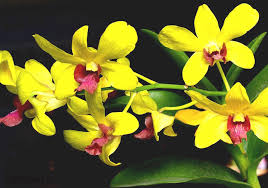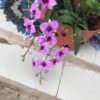# A Comprehensive Guide to Making Potting Mix for Dendrobium Orchids at Home

Dendrobium orchids are cherished for their stunning flowers and relatively easy care requirements, making them a favorite among both novice and experienced gardeners. One critical aspect of growing healthy Dendrobium orchids is using the right potting mix. This guide will provide you with everything you need to know about making a suitable potting mix for Dendrobium orchids at home, including the essential ingredients, step-by-step instructions, and tips for achieving the best results.
## Table of Contents
1. **Understanding Dendrobium Orchids**
– 1.1 Overview of Dendrobium Species
– 1.2 Importance of Potting Mix
2. **Key Ingredients for Potting Mix**
– 2.1 Bark Chips
– 2.2 Sphagnum Moss
– 2.3 Perlite and Pumice
– 2.4 Coconut Coir
– 2.5 Charcoal
3. **Step-by-Step Guide to Making Potting Mix**
– 3.1 Gather Materials
– 3.2 Prepare Ingredients
– 3.3 Mixing the Ingredients
– 3.4 Testing the Mix
4. **Customizing Your Potting Mix**
– 4.1 Adjusting Drainage and Aeration
– 4.2 Enhancing Nutrient Content
– 4.3 pH Considerations
5. **Potting Your Dendrobium Orchids**
– 5.1 Choosing the Right Pot
– 5.2 Repotting Techniques
– 5.3 Watering After Potting
6. **Common Issues and Solutions**
– 6.1 Overwatering
– 6.2 Poor Drainage
– 6.3 Nutrient Deficiencies
7. **Conclusion**
– 7.1 Recap of Key Points
– 7.2 Final Thoughts on Potting Mix for Dendrobium Orchids
—
## 1. Understanding Dendrobium Orchids
### 1.1 Overview of Dendrobium Species
Dendrobium is one of the largest genera of orchids, with over 1,800 species. They are primarily found in Southeast Asia, Australia, and the Pacific Islands, thriving in a variety of habitats, including rainforests and mountain regions. Dendrobiums are known for their unique flower shapes and colors, making them popular choices for decorative purposes.
### 1.2 Importance of Potting Mix
The potting mix you use plays a significant role in the health and growth of your Dendrobium orchids. A well-prepared potting mix provides:
– **Aeration**: Allows roots to breathe and prevents suffocation.
– **Drainage**: Prevents waterlogging, which can lead to root rot.
– **Moisture Retention**: Helps maintain adequate moisture levels without becoming soggy.
– **Nutrient Supply**: Provides essential nutrients for growth and blooming.
Choosing or creating the right potting mix can greatly impact your orchid’s growth and flowering performance.
## 2. Key Ingredients for Potting Mix
To make an effective potting mix for Dendrobium orchids, you’ll need a combination of materials that provide drainage, aeration, and moisture retention. Here are the key ingredients you should consider:
### 2.1 Bark Chips
Bark chips, usually from pine or fir trees, are a primary component in many orchid potting mixes. They offer excellent drainage and aeration, making them ideal for Dendrobiums.
– **Benefits**: Bark chips break down slowly, providing long-lasting structure to the potting mix.
– **Usage**: Use medium to large-sized bark chips to promote airflow around the roots.
### 2.2 Sphagnum Moss
Sphagnum moss is a natural material that helps retain moisture while allowing for proper drainage.
– **Benefits**: It helps maintain humidity around the roots, which is essential for Dendrobium orchids, especially in dry environments.
– **Usage**: Mix sphagnum moss with bark chips for improved moisture retention without compromising drainage.
### 2.3 Perlite and Pumice
Both perlite and pumice are lightweight volcanic materials that enhance drainage and aeration in the potting mix.
– **Benefits**: They help prevent soil compaction, ensuring that air reaches the roots.
– **Usage**: Incorporate perlite or pumice into your mix for a light and airy texture.
### 2.4 Coconut Coir
Coconut coir is a sustainable alternative to peat moss, providing moisture retention and aeration.
– **Benefits**: It is environmentally friendly, biodegradable, and helps maintain a slightly acidic pH, which is favorable for orchids.
– **Usage**: Use it in combination with bark chips and perlite for a balanced potting mix.
### 2.5 Charcoal
Charcoal is often added to orchid mixes to improve drainage and absorb impurities.
– **Benefits**: It helps keep the potting mix fresh by preventing mold and odor.
– **Usage**: Use horticultural charcoal, not the kind used for barbecues, as it is free of chemicals.
## 3. Step-by-Step Guide to Making Potting Mix
### 3.1 Gather Materials
To make your Dendrobium orchid potting mix, you will need the following materials:
– Pine or fir bark chips (medium to large)
– Sphagnum moss
– Perlite or pumice
– Coconut coir
– Horticultural charcoal
– A large container for mixing
– A measuring cup for accurate ratios
### 3.2 Prepare Ingredients
Before mixing, it’s essential to prepare your ingredients:
– **Bark Chips**: If the chips are too large, chop them into smaller pieces. This increases surface area and improves moisture retention.
– **Sphagnum Moss**: Soak the moss in water for about 15 minutes to rehydrate it before mixing.
– **Coconut Coir**: If using dry coir, soak it in water until it expands and becomes fluffy.
– **Perlite and Charcoal**: Ensure these ingredients are clean and free of dust.
### 3.3 Mixing the Ingredients
To create a balanced potting mix for Dendrobium orchids, follow these suggested ratios:
– **40% Bark Chips**
– **30% Sphagnum Moss**
– **20% Perlite or Pumice**
– **10% Coconut Coir**
– **Optional**: Add a handful of charcoal to the mix.
Combine all the ingredients in your large container and mix them thoroughly until evenly distributed.
### 3.4 Testing the Mix
Before using your potting mix, perform a simple test to ensure it meets the desired texture:
– **Moisture Test**: Take a handful of the mix and squeeze it. If it holds together but crumbles easily when you release it, it’s a good consistency.
– **Drainage Test**: Fill a small pot with the mix, water it thoroughly, and observe how quickly it drains. It should drain well but retain some moisture.
## 4. Customizing Your Potting Mix
While the above recipe serves as a great starting point, you can customize your potting mix based on specific conditions or requirements.
### 4.1 Adjusting Drainage and Aeration
If you live in a humid area, consider increasing the amount of perlite or pumice to enhance drainage. Conversely, if you are in a drier climate, you may want to add more sphagnum moss or coconut coir for increased moisture retention.
### 4.2 Enhancing Nutrient Content
To provide additional nutrients to your Dendrobium orchids, consider incorporating a slow-release orchid fertilizer into your potting mix. Follow the manufacturer’s instructions for the appropriate amount based on your mix size.
### 4.3 pH Considerations
Regularly check the pH of your potting mix to ensure it remains slightly acidic, ideally between 5.5 and 6.5. You can adjust pH levels by adding materials like sulfur to lower the pH or lime to raise it.
## 5. Potting Your Dendrobium Orchids
After preparing the potting mix, it’s time to pot your Dendrobium orchids.
### 5.1 Choosing the Right Pot
Select a pot with adequate drainage holes to prevent waterlogging. Terra cotta pots are ideal as they allow for good air circulation, but plastic pots can also work well.
### 5.2 Repotting Techniques
When repotting, gently remove the orchid from its old pot and shake off any old potting mix. Inspect the roots and trim away any dead or rotting roots. Place the orchid in the new pot, adding the fresh potting mix around it, ensuring that the root system is well-covered while keeping the top of the root ball slightly above the mix level.
### 5.3 Watering After Potting
After potting your Dendrobium orchids, water them lightly to help settle the mix and remove any air pockets. Allow the potting mix to dry out slightly before the next watering.
## 6. Common Issues and Solutions
### 6.1 Overwatering
Overwatering is a common issue with orchids. Signs include yellowing leaves and mushy roots.
**Solution**: Ensure your potting mix drains well and allow the mix to dry out between waterings. Always check the moisture level before watering.
### 6.2 Poor Drainage
If the potting mix retains too much water, it can lead to root rot.
**Solution**: Add more drainage-enhancing ingredients like perlite or charcoal to the mix, and ensure the pot has
proper drainage holes.
### 6.3 Nutrient Deficiencies
If your Dendrobium orchids are not blooming, they may be lacking nutrients.
**Solution**: Fertilize with a balanced orchid fertilizer every two to four weeks during the growing season, diluting it to half strength to prevent fertilizer burn.
## 7. Conclusion
### 7.1 Recap of Key Points
Making your potting mix for Dendrobium orchids at home is a rewarding process that allows you to customize your mix to meet the specific needs of your plants. By using the right combination of ingredients—bark chips, sphagnum moss, perlite or pumice, coconut coir, and charcoal—you can create an ideal environment for your orchids to thrive.
### 7.2 Final Thoughts on Potting Mix for Dendrobium Orchids
With this guide, you now have the knowledge to create an effective potting mix for your Dendrobium orchids. By understanding their specific needs and customizing your approach, you can enjoy beautiful, healthy orchids for years to come. Happy gardening!

